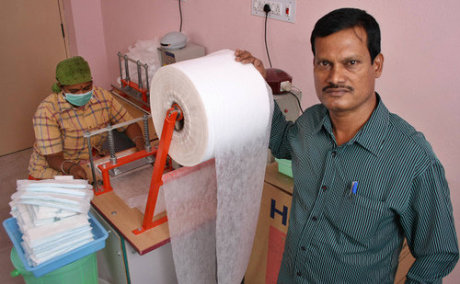One of the best examples of a widespread unmet need being met by a simple innovation was recognized last year, when a man in India, Arunachalam Muruganantham, designed and produced low cost hygienic sanitary napkins. This everyday household item that women of menstruating age take for granted in many parts of the world is actually be considered a luxury in developing countries such as India.
For instance, 88% of the women in India do not have access to sanitary pads, with this statistic being even higher in rural populations. Poverty, very little education, and heavy social stigma on women’s reproductive health in India have manifested in women using old rags, sand, sawdust, leaves and even ash during their periods. Not surprisingly, this is the root of many serious infections. In fact, it is estimated that 70% of all reproductive diseases in India are caused by poor menstrual hygiene. Furthermore, 23% of girls drop out of education once they start menstruating. In countries like India, this is not only a health problem, but is also a societal and a gender equality problem.
Mr. Muruganantham’s feats by themselves were not extraordinary from an outside perspective. He determined the composition of the commercially available pads (that most women cannot afford with regularity), designed a low-cost, effective version of the pads himself, and built a bare-bones machine that would allow any of the village women to produce them in large quantities. However, one of the primary challenges he faced was ostracization from his family and friends throughout the course of his pursuit due to their lack of knowledge regarding the necessity and utility of sanitary napkins.
Not only did he overcome these odds locally, Mr. Muruganantham spread his technology throughout the country by teaching the local women how to build and operate the machine he invented. Over time, the machines spread to 1300 villages in 23 states in India. He is hoping to continue into other developing countries, including Kenya, Nigeria, Mauritius, the Philippines, and Bangladesh. Another innovator who has approached this problem a similar way is Komera, which is a group of MIT students who created a machine that would transform banana fibres into an absorbent material that can be used to produce a sanitary pad. This machine was designed with the local villagers in Rwanda in mind, with the goal of decreasing cost and increasing access to sanitary protection for women and girls in poor communities.
These are just small feats that have already proven to be big steps for the empowerment of women and girls in poor communities, which is crucial to the endeavor to alleviate poverty in developing countries. TEL’s database contains a multitude of solution providers who are committed to these very goals: ZanaAfrica, Jayaashree Industries, Ruby Cup, and SHE LaunchPad. Details can be found in the Health & Medical Care section of the website.





